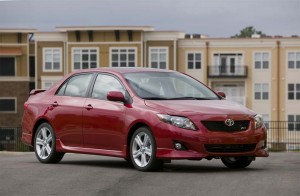
It's all on the line for Toyota, said the maker's top American exec, Jim Lentz, during a teleconference to discuss Toyota's recall plans.
“It’s up to us,” said Jim Lentz, Toyota’s top American executive, as the maker struggled to put a human face on what is rapidly becoming the worst problem in its history.
Saving an enviable reputation for quality, reliability and safety will depend, said the president of Toyota Motor Sales USA, (TMS), on the plan the maker today outlined to fix a problem with cars that can suddenly surge out of control.
Toyota announced plans to recall 2.3 million vehicles on January 19th due to its recognition that their accelerators could, under certain conditions stick, making it difficult to slow the vehicles down. Since then, the maker has increased the tally to 4.5 million, reflecting cars that it has sold in Europe and China with the same potentially defective accelerator pedal assembly.
The crisis has been worsened, analysts contend, by the fact that Toyota also recalled 3.8 million vehicles, last October, for another issue that could lead to so-called “unintended acceleration.” That problem involves loose floor mat that can “entrap” the accelerator pedal and make it difficult to release. That recall has increased in size, as well, and now includes about 5.3 million vehicles in the U.S. and Canada.
There have been reports of problems involving runaway Toyotas dating back a number of years, which is leading many observers – including analysts, government overseers, media and consumers – to question what Toyota knew and when.

Dealers expect to begin repairs on vehicles like this 2010 Toyota Corolla before the end of the week.
Following the first recall, for carpet entrapment, company spokesman Irv Miller insisted that Toyota is, “very, very confident that we have addressed this issue,” ruling out other causes. Bob Carter, the head of the Toyota Division, went even further, declaring the problem was only caused by “out-of-position and inappropriate floor mats,” and arguing that talk about other potential causes was “unwarranted speculation.”
But about that time, Toyota was beginning to receive a spate of complaints connected to other issues, most notably the sticky acceperators that have led to the latest recall. Asked about that, TMS President Lentz insisted the Japanese maker was not ignoring the issue, arguing that the problem with sticky accelerators has proven, “very difficult to isolate….because by the time the vehicle (an owner had complained about) arrived at the dealership the moisture had already evaporated and the problem no longer occurred.”
Nonetheless, Lentz and other Toyota officials continued to insist there are no other causes for unintended acceleration with the company’s products, specifically ruling out claims some outsiders have made about electronic issues with engine and other electronic control systems used on Toyota products.
“We have found no evidence” electronic systems can fail,” the executive declared, adding that there are numerous “backups and failsafes” even if a computer control system did malfunction.
Early Monday morning, Toyota issued a press release outlining what it believes to be the cause of the latest recall and what it intends to do to fix it. Under certain conditions, it explained, condensation can form inside the accelerator assembly causing the arm linked to the pedal to stick, rather than slide back and forth.
To overcome that problem, the maker’s dealers will intall a “precision cut” piece of steel, not prone to sticking, in the accelerator assemblies of vehicles already on the road as well as those now in the Toyota distribution system. However, Toyota factories will now be provided with an entirely new accelerator assembly unit also resistant to sticking.
A few days after initially announcing the recall, Toyota said it would ask dealers to halt the sale of eight affected models, while also shutting down the five North American plants that build those models. The shutdown formally went into effect today, said Lentz, who added that the plan is to reopen those operations next Monday, February 8th.
As for consumers, the necessary parts are beginning to reach dealerships around the country and repairs will likely begin this week. Bob Waltz, the executive overseeing customer service said Toyota will try to prioritize repairs, putting an emphasis on those 1.7 million owners whose vehicles are subject to both the sticky accelerator and carpet entrapment recalls.
Te automaker noted that the necessary repairs should take no more than 30 minutes and that the pace will likely pick up as service staff become more familiar with the operation.
For his part, Lentz insisted he had not yet put a price tag on the accelerator pedal recall, though Deutsche Bank analysts have estimated that the direct cost will top $550 million, and that indirect costs, including subsidies to dealers for the sales “hold” and other matters, like potential litigation, could triple the figure.
But Lentz acknowledged, in response to a series of hard questions, that the real cost will be less tangible, at least initially.
“This is embarrassing for us having this kind of recall situation, but it doesn’t mean we’ve lost our edge on quality,” said the long-time Toyota employee. Nonetheless, the danger is there, Lentz made clear, that the public’s perception could shift.
“It’s too early to tell,” he stressed, when asked what the impact on sales will be. “It all depends on how well we take care of the customers,” he added. “If we do well, the impact will be minimal, so the heat is on us to do this well.”
